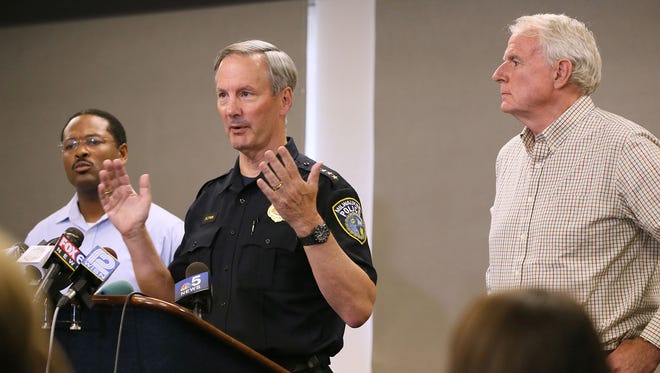Speculation about Milwaukee shooting video mounts

MILWAUKEE — Four days after a police officer fatally shot an armed man, leading to a violent disturbance in Milwaukee's Sherman Park neighborhood, the video captured by the officer’s body camera has not yet been released.
And there’s no indication it will be any time soon.
Law enforcement officials’ refusal to publicly release the footage is fueling speculation among residents and activists that it must not show what Police Chief Edward Flynn said it does: Sylville Smith, 23, turning toward officer Dominique Heaggan with a gun in his hand. That speculation exemplifies the differing perspectives toward police, often determined by race, in Milwaukee.
“Because the video has not been released yet, there’s a belief that it’s going to show that this officer was wrong and they’re trying to alter this video somehow, someway,” said Shawn Moore, an activist who helped found the Safe Zones initiative, which works to interrupt violence in the city.
Threats against Milwaukee officer intensify: 'Shoot him right in his head'
The body camera footage was turned over to the Wisconsin Department of Justice’s Division of Criminal Investigation, which is leading the probe into the fatal shooting at the request of Milwaukee police — and in compliance with a 2014 state law requiring outside investigation of officer-involved deaths.
Earlier this week, the state Justice Department released a statement saying officials there are “working expeditiously” to provide a “transparent view” of what took place, but was “not prepared to release any of the video evidence at this time.” On Wednesday, the agency said it had no other updates. A spokesman did not answer a question about whether Heaggan viewed the body camera footage before being interviewed.
Until the public sees footage proving Smith was pointing a gun at the officer, they won’t believe it, said community activist Tory Lowe.
Some black residents already are suspicious; Wauwatosa, Wis., police have not publicly released the video of a fatal police shooting two months ago.
If the Smith footage "comes back and people find out they're trying to twist it, it will create a huge problem between the streets and police," Lowe said.
As elsewhere, Milwaukee unrest decades in the making
Others expressed frustration with Flynn and Mayor Tom Barrett for describing the video — Barrett said he saw only a still frame — without releasing it.
Chris Ahmuty, executive director of the ACLU of Wisconsin, requested more transparency from the Justice Department, noting that Flynn "has already expressed conclusions drawn from a video the public has not been allowed to see."
Body cam policy
The shooting unfolded rapidly and probably only took 20 to 25 seconds from the time the officer unbuckled his seat belt to the moment he fired his gun, Flynn said.
The video apparently doesn’t answer all the questions surrounding the incident.
“I can’t tell when the officer discharges his firearm because with many body worn cameras — certainly all of ours — there’s a 30-second delay before the audio kicks on,” Flynn said Sunday. “I don’t know when the shots were fired.”
In aftermath of Milwaukee riots, 'a lot of us are lost'
It's unclear exactly when Heaggan activated the recorder.
The department’s Taser Axon Flex cameras run in “standby mode” and have a 30-second pre-buffer, meaning once an officer hits record, the previous 30 seconds of video become part of that recording — though those don’t have sound. The department chose that brand after testing four manufacturers’ devices during a 2013 pilot program.
Milwaukee police officers do not use chest-mounted cameras, because officials here wanted a recording similar to an officer’s line of sight. Officers can wear the cameras by using clear glasses or sunglasses, a metal band under the shirt collar, a headphone-like band that wraps around the back of the head or a vest mount at shoulder-level.
All of the video footage is stored off-site by Taser and, per department policy, any footage of a fatal police shooting or other critical incident is permanently retained. According to the Milwaukee Fire and Police Commission, original video is always left intact as originally recorded. A tracking feature identifies who makes any copies.
'Wild West'
Milwaukee police drafted their body camera policy after consulting with the Police Executive Research Forum, International Association of Chiefs of Police, the American Civil Liberties Union, Milwaukee beat officers and 13 law enforcement agencies across the country.
Why Milwaukee had all the 'ingredients' to become Ferguson
Still, the policy did not get high marks when measured against standards developed by The Leadership Conference on Civil and Human Rights and 30 other organizations in a report released earlier this month.
Milwaukee does some things well — it has a copy of its policy available to the public, for one — but lacks in other areas such as officers’ review of footage, said Scott Simpson, campaigns director for the conference.
Milwaukee’s policy calls for an officer involved in a critical incident to refrain from viewing any video until investigators arrive on scene. But it does not explicitly prohibit an officer involved in a critical incident from viewing the footage before giving a statement to investigators, Simpson said.
“There’s a real danger of police reports conforming to what police see on the camera,” he said. “If you don’t have independent recollection you lose a really valuable piece of evidence.”
Milwaukee wasn’t the only policy to fall short, Simpson said.
“No one did very well,” he said. “It’s the Wild West out there, and there aren’t clear national standards.”
Contributing: Gina Barton, Milwaukee Journal Sentinel. Follow Ashley Luthern on Twitter: @aluthern
